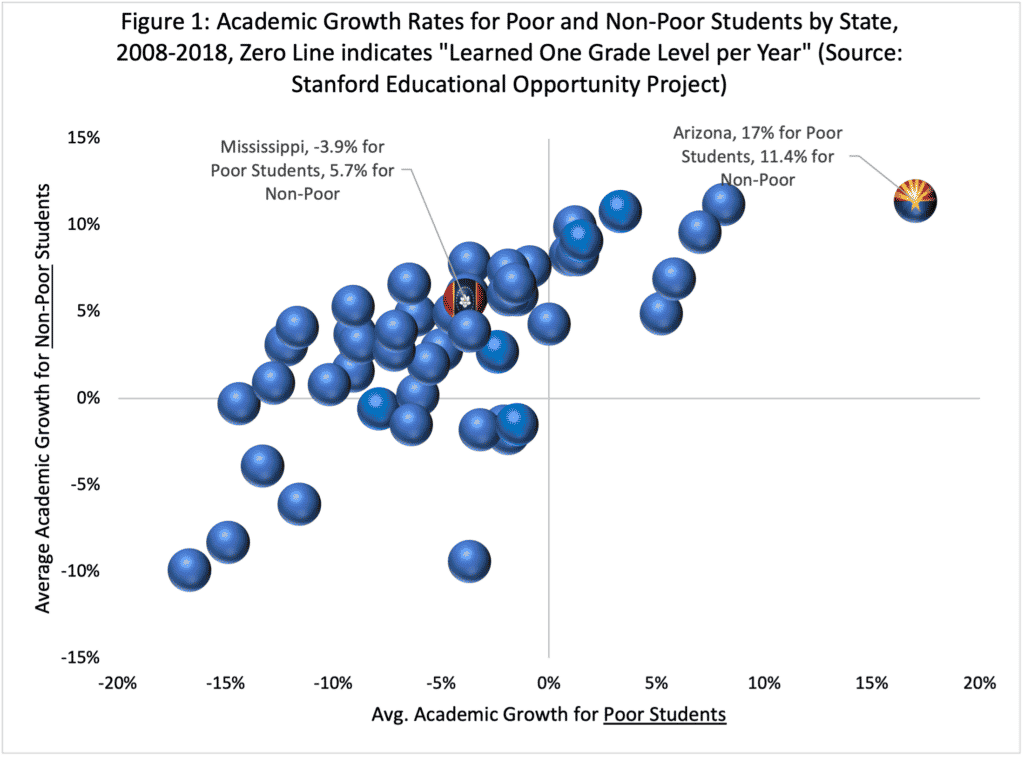My father grew up in Gulfport, my parents met as Ole Miss students, and I have lived in Arizona since 2003. Arizona has been and remains the top state for school choice policies for decades. Given this background I’ll offer up what I hope will be a useful comparison between Mississippi and Arizona, focusing on rural schools.
Struggling to keep up with non-stop student enrollment growth, Arizona lawmakers adopted a robust charter school law in 1994 along with a statewide district open enrollment policy. In 1997 lawmakers created the nation’s first scholarship tax credit program (since much copied in other states.) Arizona lawmakers spent the aughts expanding that tax credit program, and then passed the nation’s first Education Savings Account program in 2011- since much copied in other states including Mississippi. A study of overall education freedom conducted in 2001 ranked Arizona first overall. A recreation of that study in 2021 again found Arizona ranked first overall.
So how is that working out for Arizona? Arizona is a relatively low-income state with a majority-minority student population which includes a large and growing Hispanic student population and the second largest Native American student population. On proficiency, Arizona is holding the rough end of multiple achievement gap sticks. If however, you look deeper you find evidence of enormous success in the Grand Canyon State.
Scholars regard academic growth as the best measure of school quality, in part because it is not nearly as strongly correlated with student demographics. Academic growth measures show how much students learn per year of schooling. Stanford University’s Educational Opportunity Project has linked state accountability exams from across the country, currently for the 2008-2018 period. Academic growth is where Arizona shines, as shown in Figure 1 below. Figure 1 shows the average academic growth rates for poor students and non-poor students for both Arizona and Mississippi:

The secret sauce of Arizona’s success: pluralism. Arizona charter schools include a wide diversity of approaches: several different variations of classical education, rigorous STEM models, schools focused on the performing arts, equestrian schools, and much more. If you can imagine it, it’s probably out there to be found. Arizona families thus have had the opportunity to match the aspirations and interests of their children to the focus and strengths of particular schools. Educators and families, working in tandem, have slowly but steadily shaped the K-12 space: making more of certain kinds of school seats, and less of others.
So on to our true subject: rural education. Many critics of choice claim that choice will destroy rural education. Rural areas of Arizona not only have open enrollment opportunities, and access to charter schools, but they also have expanded access to private schools through tax credits and education savings accounts. If we are going to look for evidence of choice harming rural education, rural Arizona is the best place to search for it.
The United States Census Bureau lists 340,000 or so Arizonans living in rural communities out of a total population of just over seven million. The total statewide population of Mississippi is just under 2.9 million people. The National Alliance for Public Charter Schools shows 64 charter schools operating in rural Arizona communities. The statewide number of charter schools in Mississippi is…nine.

Did Arizona rural school districts wither under the competition of 64 charter schools and multiple private choice programs? In a word, no. Arizona’s rural school districts are still there, and the same source of academic data from Stanford University shows high levels of academic growth among Arizona’s rural schools. Charter schools contributed directly to this high level of growth. Among Arizona’s rural charter schools in the Stanford data, students learn an average of 20% more than the normal amount of learning a student receives in a single grade level.
Fortune favors the bold and pluralism has a great deal to offer Mississippi’s rural communities. At Mississippi’s currently timid rate of charter opening, few readers of this post will live to see the day when Mississippi’s statewide total for charter schools equals the 2019 total for rural Arizona charters. Mississippi’s students, families, and educators deserve much better.
Do you support education freedom for families in Mississippi?
(function(d, s, id) {
var js, fjs = d.getElementsByTagName(s)[0];
if (d.getElementById(id)) return;
js = d.createElement(s); js.id = id;
js.src = ‘//p2a.co/js/embed/widget/advocacywidget.min.js’;
fjs.parentNode.insertBefore(js, fjs);
}(document, ‘script’, ‘advocacy-actionwidget-code’));

